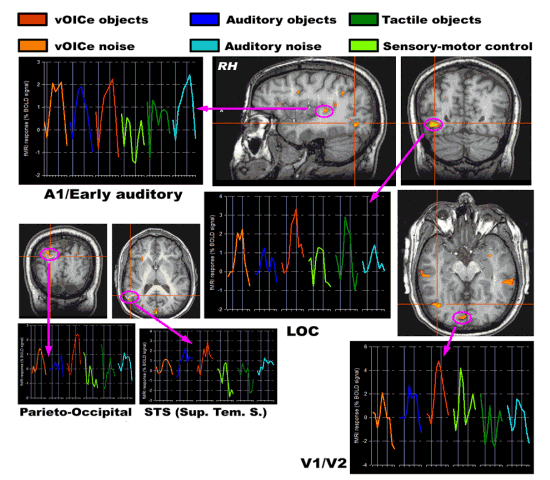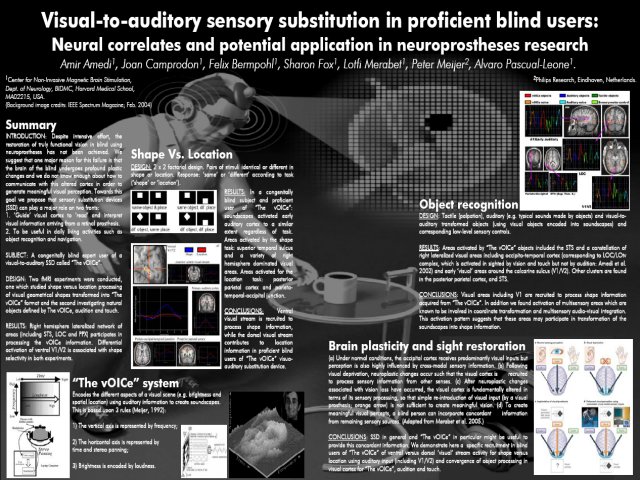Visual-to-auditory sensory substitution in proficient blind users:
Neural correlates and potential application in neuroprostheses research
« The vOICe Home Page
A poster based on use of The vOICe was presented at
CNS 2005
the 12th Annual Meeting of the
 Cognitive Neuroscience Society
Cognitive Neuroscience Society
April 9-12, 2005, New York, USA.
Mentioned in December 2005 in  The New York Times.
The New York Times.
First author:
Amir Amedi.
Poster E-288 - Monday, April 11, 2005, 15:30 - 17:30.
 Authors
Authors
Amir Amedi 1, Felix Bermpohl 1,
Joan Camprodon 1, Sharon Fox 1,
Lotfi Merabet 1, Peter Meijer 2
and Alvaro Pascual-Leone 1.
1 Center for Non-Invasive Magnetic Brain Stimulation, Dept. of Neurology, BIDMC, Harvard Medical School, MA02215, USA.
2 Philips Research, Eindhoven, The Netherlands. [Update: currently no longer working at Philips.]
Abstract
Neural correlates of visual-to-auditory sensory substitution in proficient blind users
Restoration of sight in a blind person imposes great clinical and scientific challenges.
Despite intensive efforts, restoration of truly functional vision using neuroprostheses
 has not been achieved. We suggest here that a major reason for this failure is that the
brain in the blind undergoes profound plastic changes and we do not know enough about how
to communicate with this altered cortex to generate meaningful visual perception. We
propose that sensory substitution devices (SSD) can play a major role in two fronts: 1.
'Guide' the visual cortex to 'read' and interpret the visual information arriving from a
retinal prosthesis in a blind subject 2. To be useful in daily life for blind people to
perceive and recognize visual input, transformed to their intact senses. Visual-to-tactile
and visual-to-auditory sensory substitution devices (SSD) can be useful for blind
individuals to perceive visual scenes. In SSD, visual images are captured by a camera and
then transformed into tactile stimulation or into sound. The brain is able to learn to
use this information, but the neural mechanisms responsible for this process have not
been elucidated. We report here findings of behavioral and fMRI results in two blind (one
congenitally blind and one late blind), expert users of a visual-to-auditory SSD called
The vOICe. This system encodes the different aspects of a visual scene (brightness and
spatial location) using auditory information ('soundscapes') based upon 3 simple rules:
1) the vertical axis is represented by frequency; 2) the horizontal axis is represented
by time and stereo panning; and 3) brightness is encoded by loudness (Meijer, 1992). Two
experiments were conducted, one which studied shape versus location processing of visual
geometrical shapes transformed into The vOICe format. In the second experiment we
compared object recognition using The vOICe with auditory and tactile object recognition.
The results suggest that a right hemisphere lateralized network of areas participates in
processing The vOICe information. This includes posterior occipital areas, the
superior-temporal sulcus, the occipito-temporal cortex and occipito-parietal cortex.
Differential activation of ventral V1/V2 is associated with shape versus location decisions
using The vOICe. We will further present the difference between tactile and soundscape-based
object recognition as well as difference between the congenitally and late blind and suggest
a general framework on how to use this result in visual restoration efforts.
has not been achieved. We suggest here that a major reason for this failure is that the
brain in the blind undergoes profound plastic changes and we do not know enough about how
to communicate with this altered cortex to generate meaningful visual perception. We
propose that sensory substitution devices (SSD) can play a major role in two fronts: 1.
'Guide' the visual cortex to 'read' and interpret the visual information arriving from a
retinal prosthesis in a blind subject 2. To be useful in daily life for blind people to
perceive and recognize visual input, transformed to their intact senses. Visual-to-tactile
and visual-to-auditory sensory substitution devices (SSD) can be useful for blind
individuals to perceive visual scenes. In SSD, visual images are captured by a camera and
then transformed into tactile stimulation or into sound. The brain is able to learn to
use this information, but the neural mechanisms responsible for this process have not
been elucidated. We report here findings of behavioral and fMRI results in two blind (one
congenitally blind and one late blind), expert users of a visual-to-auditory SSD called
The vOICe. This system encodes the different aspects of a visual scene (brightness and
spatial location) using auditory information ('soundscapes') based upon 3 simple rules:
1) the vertical axis is represented by frequency; 2) the horizontal axis is represented
by time and stereo panning; and 3) brightness is encoded by loudness (Meijer, 1992). Two
experiments were conducted, one which studied shape versus location processing of visual
geometrical shapes transformed into The vOICe format. In the second experiment we
compared object recognition using The vOICe with auditory and tactile object recognition.
The results suggest that a right hemisphere lateralized network of areas participates in
processing The vOICe information. This includes posterior occipital areas, the
superior-temporal sulcus, the occipito-temporal cortex and occipito-parietal cortex.
Differential activation of ventral V1/V2 is associated with shape versus location decisions
using The vOICe. We will further present the difference between tactile and soundscape-based
object recognition as well as difference between the congenitally and late blind and suggest
a general framework on how to use this result in visual restoration efforts.
Poster
The poster is available as a
 PDF file (760 KB). PDF file (760 KB).

|
Poster references
P. B. L. Meijer, ``An Experimental System for Auditory Image Representations,''
IEEE Transactions on Biomedical Engineering, Vol. 39, No. 2, pp. 112-121, Feb 1992. Reprinted
in the 1993 IMIA Yearbook of Medical Informatics, pp. 291-300.
L. B. Merabet, J. F. Rizzo, A. Amedi, D. C. Somers and A. Pascual-Leone,
``Opinion: What blindness can tell us about seeing again: merging neuroplasticity and neuroprostheses,''
Nature Reviews Neuroscience, Vol. 6, pp. 71-77, 2005.
Related is also the conference presentation at the Annual Meeting of the Society for Neuroscience (SfN 2004)
in San Diego, USA, October 23-27, 2004, titled "Seeing through the ears? Identification
of images converted to sounds improves with practice".
The above results were also presented at the 57th Annual Meeting of the American Academy of Neurology
(AAN 2005), Miami Beach, Florida, on Sunday April 10, 2005 in the Enhanced Vertical Integration sessions
(EVNO.026, Neuro-Ophthalmology / Neuro-Otology, subcategory Imaging, 12:00 PM - 6:00 PM), and on Tuesday April 12, 2005 in Poster Session I
(P01.023, Neuro-Ophthalmology / Neuro-Otology, 7:30 AM - 12:00 PM).
An extended follow-up presentation was given at the 6th Annual Meeting of the International Multisensory
Research Forum (IMRF 2005), Rovereto, Italy, June 5-8, 2005, in a symposium titled "Can the Blind See?", with
a presentation by Amir Amedi and Peter Meijer, also titled
"Neural correlates of visual-to-auditory sensory substitution in proficient blind users",
June 6, 2005.
Used acronyms: STS stands for Superior Temporal Sulcus, LO or LOC stands
for Lateral Occipital Complex, LOtv stands for Lateral Occipital Tactile-Visual region,
PPX stands for Posterior Parietal Cortex.
Note: The vOICe technology is being explored and developed under the Open Innovation
paradigm together with R&D partners around the world.
Copyright © 1996 - 2024 Peter B.L. Meijer
![]() The New York Times.
The New York Times. Authors
Authors